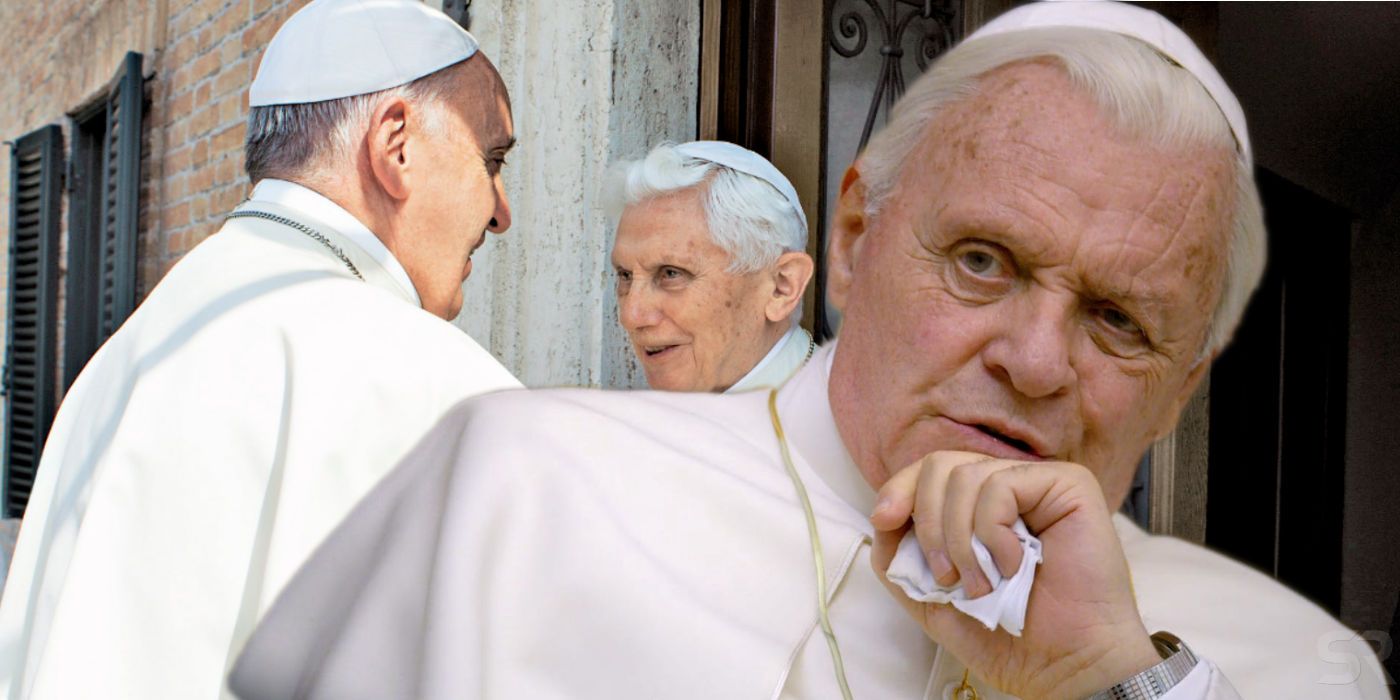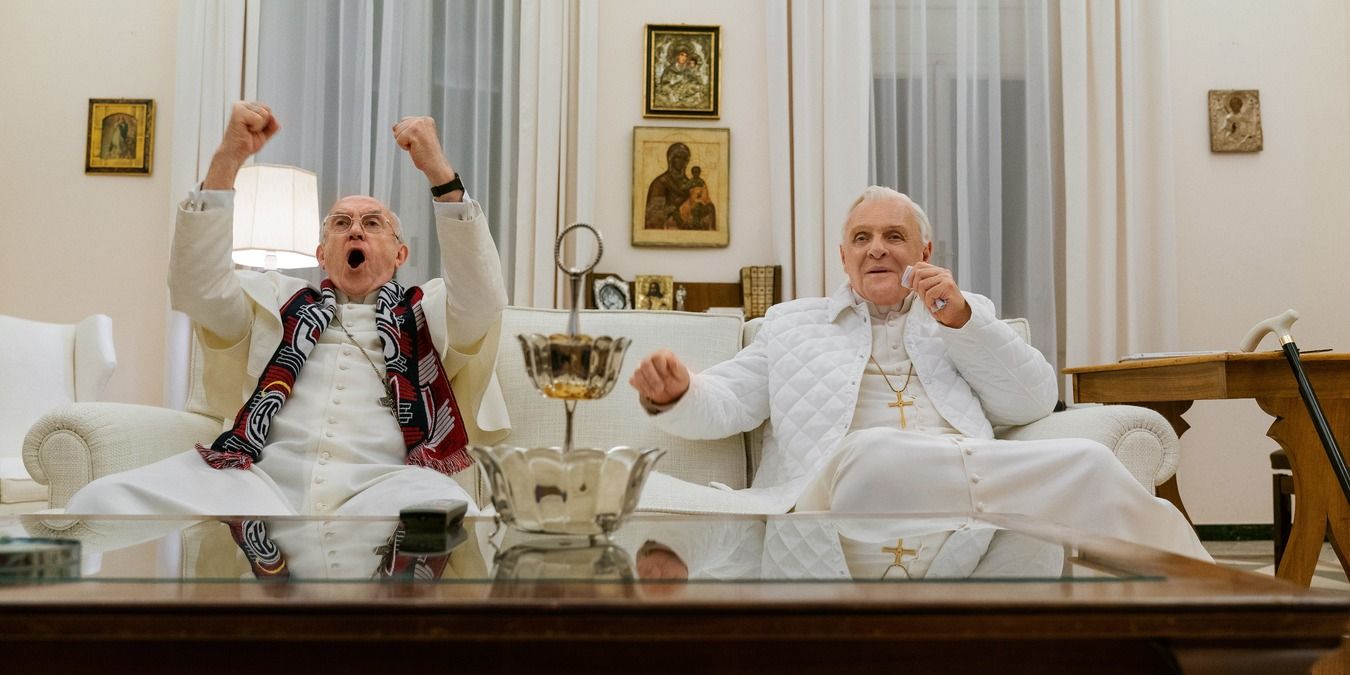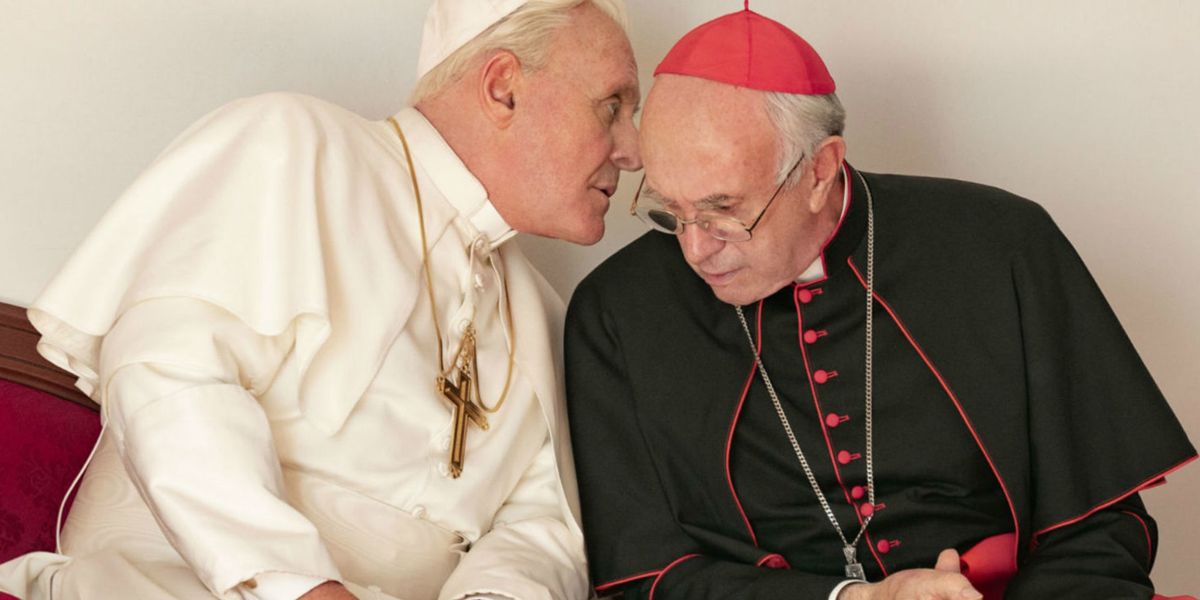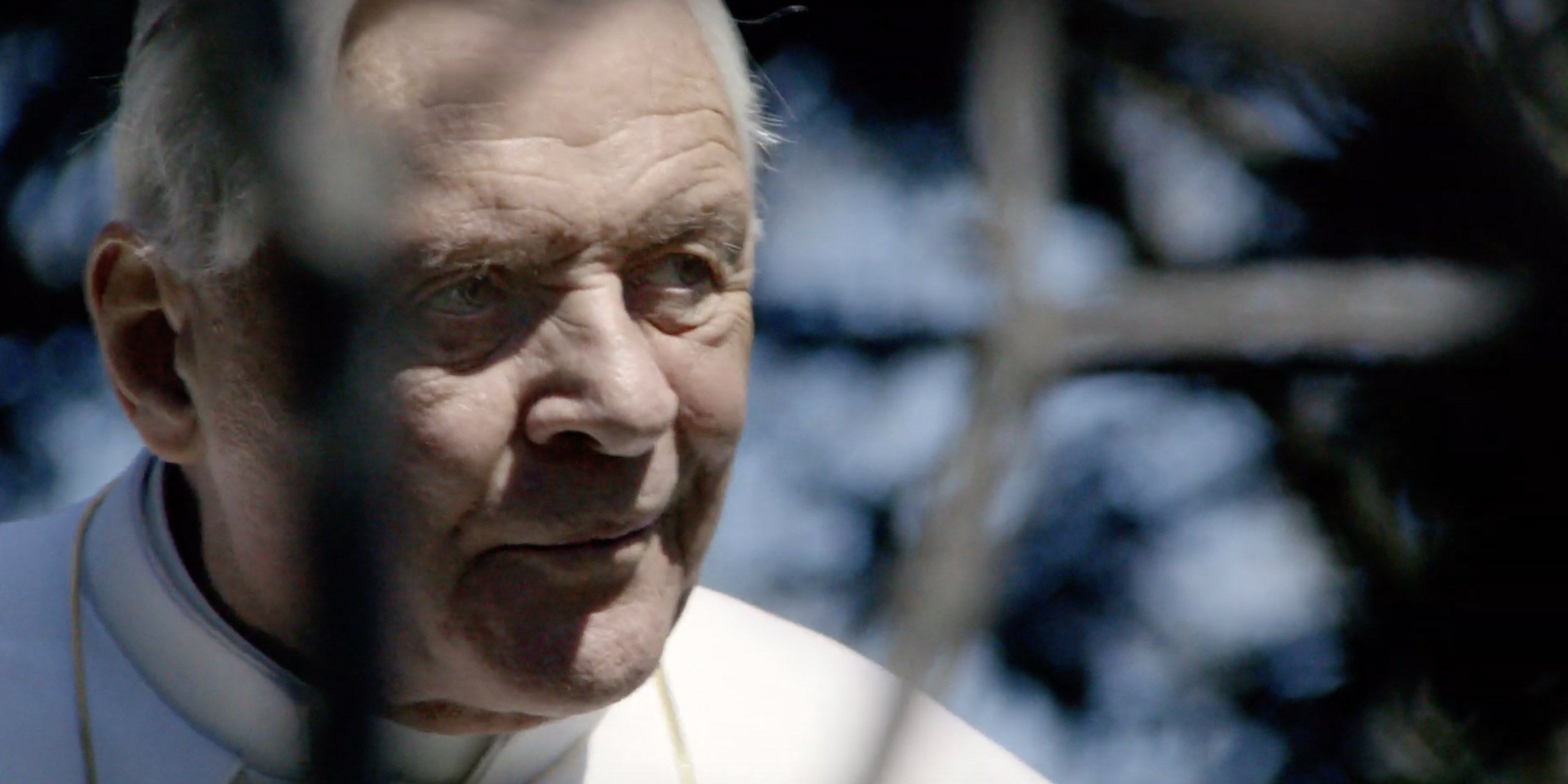Netflix’s The Two Popes movie imagines a series of meetings between the previous and current Pope, but in doing so, The Two Popes true story can be skewed. There are many 2019 films that Netflix are hoping will help them further make an impact on the Academy Awards. Martin Scorsese’s The Irishman is the jewel in the streaming service’s crown, while Noah Baumbach’s Marriage Story presents their best chance at acting awards thanks to Adam Driver and Scarlett Johansson. Eddie Murphy could be a dark horse contender thanks to his stellar work in Dolemite is My Name. And then there is The Two Popes.
Directed by Fernando Meirelles of City of God fame, this pseudo-biographical drama imagines a series of meetings between Cardinals Joseph Ratzinger and Jorge Bergoglio, the previous and current Popes. The Two Popes movie has been on Oscar predictors’ radars since its announcement in large part thanks to its baity concept, the hype surrounding actors Anthony Hopkins and Jonathan Pryce, and the presence of screenwriter Anthony McCarten, whose three previous works nabbed Best Actor Oscars for their respective leads.
Based on his own play, McCarten hypothesizes a series of conversations between the two figureheads of the Catholic Church, each with seemingly opposing viewpoints on the institution's needs and agendas. Benedict XVI is a hard-line traditionalist who is seen as a relic of the past while the future Pope Francis, a Jesuit who prioritizes a peaceful life of caring for the poor, is positioned as what the Church needs to stay relevant in the 21st century. It’s certainly an intriguing concept and one that makes for some interesting philosophical quandaries which make up the lion’s share of the film. The Two Popes is more metaphor than biopic, a movie that literalizes the issues of Catholicism in the current age through the two men who many see as representative of the paradigm shift from old to new. The big question for viewers, however, is how much of The Two Popes true story is shown in the movie.
Did The Meetings Happen?
These two real-life figures of great importance to millions of Catholics everywhere are used more as metaphorical tools to ask greater philosophical questions about the Church than anything else. When viewed as such, The Two Popes makes a lot more sense than if you see it as just another biopic.
Pope Benedict XVI never met with Cardinal Bergoglio to discuss his retirement or to encourage him to put himself forward as the next candidate for the Papacy. That was entirely made up by McCarten. The meeting as shown in The Two Popes is also shown as an excuse for Bergoglio to try and submit his resignation as bishop, something Benedict repeatedly denies. This is revealed as Bergoglio wanting to step away from the stresses of the Church, but in reality, all bishops must do this. Article 401.1 of the Latin-Rite Code of Canon Law states that "A diocesan Bishop who has completed his seventy-fifth year of age is requested to offer his resignation from office to the Supreme Pontiff, who, taking all the circumstances into account, will make provision accordingly."
As noted by American Magazine, Pope Benedict and Bergoglio possibly did meet in the Vatican, but not as The Two Popes shows. It is more likely that it would have happened when the Argentine bishops made their “ad limina” visits. These are regular required visits to the Vatican so that bishops can report on the state of their dioceses.
Did The Divide Exist?
The generally accepted narrative surrounding Popes Benedict XVI and Francis are that they were representative of the two sides of the Catholic Church: The traditionalists and the modernists. Ratzinger was seen as the old-school theologian cut from a staunchly conservative cloth who advocated a return to the fundamentals of Christian values in everyday life, especially in the face of growing secularism worldwide. Bergoglio, by contrast, was viewed as the man of the people, the Jesuit who rejected the often obscene wealth trappings of the church in favor of simple living and a more hands-on approach to the Papacy.
In The Two Popes, Benedict frequently notes how Bergoglio disagrees with his stances, both publicly and privately, and takes particular umbrage with his more lavish lifestyle. Benedict’s tenure as Pope is viewed in The Two Popes as one of increasing irrelevance in the modern age and one steeped in scandal, such as the Vatican leaks scandal wherein leaked documents exposed alleged corruption and power struggles within the Church. Paolo Gabriele, who had been the Pope's personal butler since 2007, was eventually arrested by Vatican police and found guilty of theft.
While the pair do differ on some major issues and approaches to the Papacy, their differences are more rooted in theology than the active duties of the job. As noted by the Catholic Herald, "Pope Francis does not have opposite theological leanings [to Benedict], so much as he has little interest in theology, except as a tool of ecclesiastical policy." In short, The Two Popes, as it focuses more on using these men as conduits for bigger questions than in telling their truth, is unconcerned with the deeper and more intricate policies of Catholicism. That's hardly a bad thing. Turning all of that into a film would probably be an insufferable drag and not something general audiences are keen to watch. The Two Popes also reflects a wider perception of the Church: Francis is generally more popular than Benedict and is seen as a step forward, regardless of whether or not he actually is.
How Much Is Real?
As noted above, The Two Popes generally isn’t concerned with close adherence to the truth so much as spinning a story of theological interest that is true in spirit. There are moments of The Two Popes true story sprinkled throughout. Bergoglio is a lifelong fan of the San Lorenzo football team but he never watched Germany beat Argentina at the World Cup with Benedict. Benedict first told his personal secretary, Msgr. Georg Gänswein, his brother, Father Georg Ratzinger, and Cardinal Angelo Sodano, the Dean of the College of Cardinals, about his decision to resign, not Bergoglio, and the decision was reportedly made entirely on his own. Some time is given to Bergoglio’s past in Argentina and his involvement during the country's Dirty War, wherein he was accused of not doing enough to oppose the dictatorial government. Interestingly, a lot of time is given to Bergoglio’s past but very little to Ratzinger’s, although his past involvement in the Hitler Youth is derisively referred to on a couple of occasions.
The issue of Benedict’s shoes became a strange talking point during his Papacy, one that came to symbolize his apparently out-of-touch approach to the job, in contrast to the simple way of life preached and practiced by Bergoglio. As the Catholic Herald notes:
"Benedict wore the red shoes almost as a reminder to himself of the office into which he had come, while Pope Francis kept wearing his old shoes because he has a friend in Argentina who has made and repaired his shoes for 40 years. To the extent that the contrast in footwear is telling of anything, it is of the ways in which both men are uncomfortable with the office. What effect their discomfort with the office has on their conduct of it would be interesting to explore."
The best way to view The Two Popes true story may be to think of it as wish-fulfillment fantasy, akin to Catholics what The West Wing was for Democrats and liberals during George W. Bush’s Presidency. This is a film of ideas that presents a bright future for one of the most powerful institutions on the planet. There are massive problems with this approach – the Catholic Church doesn’t exactly need a cutesy movie makeover and certain topics just aren’t great for exclusively abstract conversations – but as it stands, it’s not hard to see why The Two Popes has won over skeptics and believers alike.




